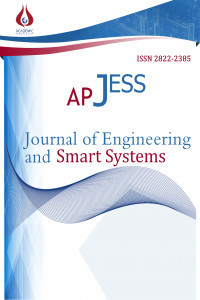Endüstriyel Delme Artığı ile Üretilmiş Cam Elyaf Takviyeli Çimento Bazlı Kompozitlerin Mekanik Özellikleri
delme artığı, çimento bazlı kompozit, cam elyaf
Mechanical Performances of Glass Fiber Reinforced Cementitious Composites Made with Punching Scrap
Punching scrap, cementitious composite, glass fiber,
___
- [1] Bentur, A., and S. Mindess. Fibre reinforced cementitious composites. CRC Press, 2014.
- [2] Halpin, J. C. Primer on Composite Materials Analysis, (Revised). Routledge, 2017.
- [3] Kasagani, H., and C. B. K. Rao. "Effect of graded fibers on stress strain behaviour of Glass Fiber Reinforced Concrete in tension." Construction and Building Materials 183 (2018): 592-604.
- [4] Betterman, L. R., C. Ouyang, and S. P. Shah. "Fiber-matrix interaction in microfiber-reinforced mortar." Advanced Cement Based Materials 2.2 (1995): 53-61.
- [5] Song, P. S., and S. Hwang. "Mechanical properties of high-strength steel fiber-reinforced concrete." Construction and Building Materials 18.9 (2004): 669-673.
- [6] Neville,A.M., Brooks, J.J., (1987) Concrete Technology Longman Scientific and Technical, p.285.
- [7] Dehghan, A., Karl P., and A. Shvarzman. Recycled glass fiber reinforced polymer additions to Portland cement concrete. Construction and Building Materials 146, 2017: 238-250.
- [8] Sathanandam, T., Low carbon building: Experimental insight on the use of fly ash and glass fibre for making geopolymer concrete. Sustainable Environment Research 27.3 (2017): 146-153.
- [9] Mastali, M., A. Dalvand, and A. R. Sattarifard. The impact resistance and mechanical properties of reinforced self-compacting concrete with recycled glass fibre reinforced polymers. Journal of Cleaner Production, 124 2016: 312-324.
- [10] Vijayalakshmi, M., and A. S. S. Sekar. Strength and durability properties of concrete made with granite industry waste. Construction and Building Materials 46, 2013: 1-7.
- [11] Marcondes, P.V.D., Eto, A.M., P.A.C. Beltrǎo, P.C. Borges, A smart stamping tool for punching and broaching combination, Journal of Materials Processing Technology,206(2008) 184–193.
- [12] Hatanaka N., Yamaguchi K., Takakura N. and Iizuka T. Simulation of sheared edge formation process in blanking of sheet metals, Journal of Materials Processing Technology, 140,2003: 628–634.
- [13] Myint, M. H. Evaluation of wear mechanisms of Y-TZP and tungsten carbide punches." Journal of Materials Processing Technology 140.1-3,2003: 460-464.
- [14] Gang F., Zeng P., and Lou, L. Finite element simulation of the effect of clearance on the forming quality in the blanking process. Journal of Materials Processing Technology 122.2-3, 2002: 249-254.
- Yayın Aralığı: Yılda 3 Sayı
- Başlangıç: 2022
- Yayıncı: Akademik Perspektif Derneği
Mustafa YÖNTEM, Abdullah GÜMÜŞ, Remzi ABALI, Meltem ÖZNUR, Fatih ERCİ, Behiç Selman ERDOĞDU
Muğla Dalaman Havalimanı Uçaklardan Kaynaklanan Karbon Ayak İzinin Belirlenmesi
Kazım KUMAŞ, Onur İNAN, Ali Özhan AKYÜZ, Afşin GÜNGÖR
Fren Balatası Üretimi için Zirkonya Esaslı Yeni Kompozisyonların Geliştirilmesi
Arife YURDAKUL, Nurdan BAŞTÜRK
Yusuf ARSLAN, Sadık Alper YILDIZEL
Soya Yağı ile Kömür Yıkama Tesis Atıklarından Temiz Yakıt Üretimi
Hasan HACIFAZLIOĞLU, Yakup EKER, Abdul Vahap KORKMAZ
Sürekli Optimizasyon Problemleri için Çoklu Arama Stratejisi Kullanan Fil Sürü Optimizasyonu
Berna İSTEGÜN, Ayşenur Subaşı, Erkan Çelebi
Amorf Yarıiletken InTe İnce Filminin Üretilmesi ve Karakterizasyonu
